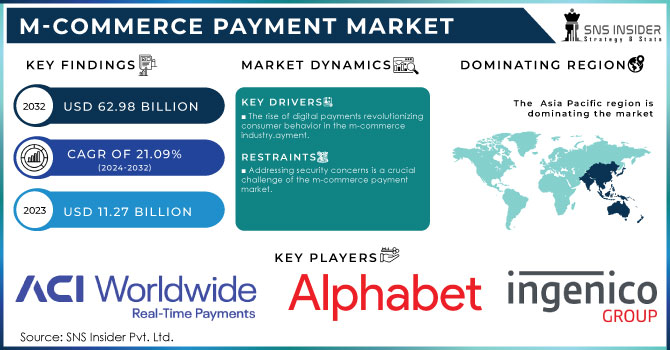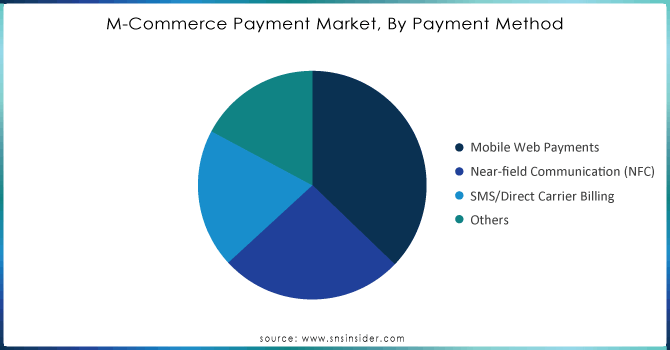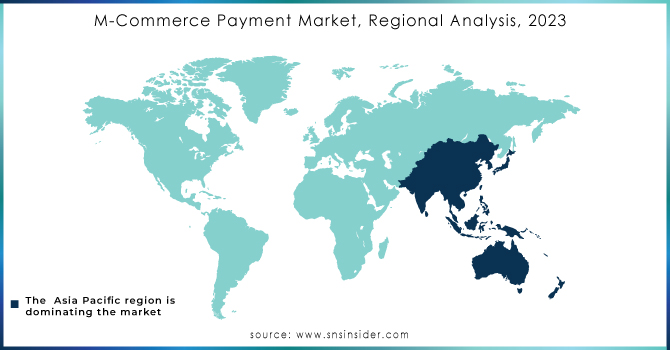M-commerce Payment Market Report Scope & Overview:

Get more information on M-commerce Payment Market- Request Sample Report
The M-Commerce Payment Market was valued at USD 11.27 Billion in 2023 and is expected to reach USD 62.98 Billion by 2032, growing at a CAGR of 21.09% over the forecast period 2024-2032.
The M-commerce payment market, a crucial segment of the broader mobile commerce ecosystem, has witnessed rapid growth over the past few years. This growth is driven by the proliferation of smartphones, advancements in mobile technology, and the increasing adoption of digital payment solutions. As a result, the mobile phone e-commerce industry has reached an impressive valuation of USD 2.2 trillion, reflecting a significant shift in consumer shopping behavior. This surge in the M-commerce payment market can be attributed to the convenience and accessibility that mobile devices offer, allowing users to shop anytime and anywhere. Over 56% of global consumers now prefer mobile devices for shopping, with mobile commerce apps expected to capture 78% of global e-commerce traffic, outpacing traditional desktops and tablets.
In 2024 i.e. 70% of purchases were made through mobile apps rather than websites. Additionally, 65% of mobile users have made purchases based on influencer recommendations, demonstrating the growing impact of social media on consumer decisions. The average transaction value for mobile shopping is USD 120, reflecting consumers' increasing trust in mobile platforms. Mobile apps have significantly higher engagement rates than traditional e-commerce avenues, with a conversion rate of 3.5% compared to 2% for mobile websites. Users engage more deeply with mobile shopping apps, viewing products 4.2 times more per session. The cart abandonment rate for mobile apps is also notably lower at 20%, indicating more effective sales processes.
M-Commerce Payment Market Dynamics
Drivers
- The rise of digital payments revolutionizing consumer behavior in the m-commerce industry.
The increasing use of digital payment options is changing how consumers behave and playing a big role in the growth of the m-commerce payment industry. Digital payment solutions like mobile wallets, peer-to-peer systems, and contactless cards are gaining popularity as customers look for quicker and more secure payment options. Digital payment solutions provide a range of advantages, such as convenience, security, and quick transactions. Customers can make immediate payments without the need to have cash or physical cards, which improves the overall shopping experience. Incorporating biometric authentication techniques like fingerprints and facial recognition improves security even more, addressing worries regarding fraud and identity theft. This trust in online payments motivates customers to adopt mobile commerce platforms, resulting in higher transaction amounts. Moreover, the increase in online shopping platforms and mobile apps has led to a situation where electronic transactions are crucial. Retailers are more and more embracing digital payment solutions to meet evolving consumer demands. Numerous e-commerce platforms currently give importance to mobile-first approaches, making sure their websites and apps are tailored for mobile users. Consequently, mobile commerce payment options are becoming increasingly common.
- Contactless payments are on the rise, revolutionizing mobile commerce and improving the consumer experience.
The move towards contactless payments has transformed the payment environment in mobile commerce, leading to notable market expansion. Consumers are increasingly opting for easy and clean payment options like contactless payment methods, such as NFC technology, QR codes, and mobile wallets, due to their convenience and hygiene benefits. Furthermore, contactless payments improve the shopping experience by providing added convenience. Customers can swiftly finalize purchases, leading to decreased wait times and enhanced productivity. This rapid pace is especially advantageous in busy retail settings, where extended queues can dissuade potential shoppers. Therefore, retailers who adopt contactless payment options can improve customer satisfaction and boost sales. The inclusion of contactless payment technologies in different platforms continues to drive the expansion of the m-commerce payment industry. Numerous retailers currently provide mobile applications that enable customers to buy products directly from their devices, facilitating smooth transactions. Linking loyalty programs and promotions to contactless payments also boosts consumer engagement and spending.
Restraints
- Addressing security concerns is a crucial challenge of the m-commerce payment market.
Even with improvements in security technologies, worries about security still hinder the growth of the m-commerce payment market. High-profile data breaches and fraud cases have increased consumer knowledge about the dangers of mobile payments. Consumers might be reluctant to disclose sensitive financial details on mobile apps due to concerns about unauthorized access and potential financial harm. The threat of identity theft is a major worry for customers participating in mobile commerce transactions. Cybercriminals frequently use advanced methods to steal personal and financial data, causing heightened worry among potential users. Moreover, the increasing occurrence of phishing attacks and malware directed at mobile devices intensifies these worries. Consumers might avoid using m-commerce payment options because they are afraid of being scammed or defrauded. Additionally, consumer ignorance about mobile payment security adds to these worries. Numerous consumers might not have a complete grasp of the functioning of mobile payment systems or the security protocols in place to safeguard their data. Being transparent about how data is handled and the security protocols in place can also contribute to building trust with consumers. Nevertheless, as long as these issues are not effectively resolved, they will still hinder the expansion of the m-commerce payment sector.
M-Commerce Payment Market Segmentation Overview
By Payment Method
Mobile web payments led the market segment in 2023 with a 37.00% market share, fueled by the growing use of smartphones and wide internet availability. This technique enables customers to conduct transactions via mobile browsers, making shopping more convenient. 2.71 billion people around the globe are making online purchases from dedicated eCommerce platforms or social media stores. Mobile web payments improve the buying process by offering one-click payments and storing payment details, which decreases the rates of abandoned carts. Key players, including PayPal and Stripe, have enhanced their platforms for mobile functionality, providing smooth payment integration for e-commerce merchants.
Near-field Communication (NFC) is quickly gaining growth rate and is to become the fastest-growing segment during 2024-2032. NFC allows for contactless payments by enabling devices to communicate with each other when nearby, ensuring fast and secure transactions. Apple and Google have created strong mobile wallet apps, including Apple Pay and Google Wallet, that use NFC technology for safe transactions. Companies such as Starbucks and McDonald's have also incorporated NFC payment systems to improve customer satisfaction and simplify the payment process.

Do you need any customization data on M-commerce Payment Market - Enquire Now
By Transaction Type
M-retailing dominated the market with a 44.00% market share in 2023. This section allows individuals to purchase products and services using mobile gadgets like smartphones and tablets, providing convenience and easy access. Retailers use mobile apps and websites to offer a smooth shopping experience, incorporating features such as personalized suggestions, mobile payment options, and loyalty programs. 20.1% of retail purchases are expected to take place online in 2024 and this share will further rise to 22.6% by 2027. For example, Amazon has strong mobile apps that make browsing, buying, and paying simple, increasing user interaction and boosting sales. Amazon Pay handled 72.4 million transactions, which is about 0.5% of all UPI transactions.
M-ticketing and booking are the most rapidly expanding segment in the m-commerce payment market over 2024-2032, fueled by the rising use of mobile devices and the increasing need for convenient travel and event services. This portion consists of mobile apps that let users buy tickets for transportation, concerts, movies, and other events using their smartphones. The rapid expansion of ticket accessibility anytime anywhere is driven by convenience. Companies such as Ticketmaster and Expedia showcase this pattern, offering easy-to-use platforms that assist in smooth booking and payment procedures.
M-Commerce Payment Market Regional Analysis
APAC held a 37.00% market share in 2023 and led the market, driven by a large population, fast urbanization, and extensive smartphone usage. Nations such as China and India are leading the way in incorporating mobile payment solutions into everyday transactions. Alipay and WeChat Pay in China showcase how effective m-commerce can be by allowing users to easily make transactions for shopping and utility payments. Furthermore, India has experienced a rise in mobile payment apps such as PhonePe and Google Pay, because of government efforts to encourage digital payments and financial inclusion.
North America is to show a significant growth rate during 2024-2032, due to quick technological advancements, widespread smartphone use, and the rising popularity of digital wallets. The area's strong infrastructure and emphasis on innovation enable the advancement of cutting-edge payment solutions, improving consumer experiences. For example, Venmo, a company owned by PayPal, has become extremely popular with younger age groups by offering fast and interactive payment choices. Moreover, major online retailers such as Amazon and Walmart are incorporating mobile commerce features, enabling consumers to easily make purchases using their mobile applications.

Key Players in M-Commerce Payment Market
The major key players in the M-commerce Payment Market are:
-
ACI Worldwide, Inc. (ACI Secure EPN, ACI Universal Payments)
-
Alphabet Inc. (Google) (Google Pay, Google Wallet)
-
Apple Inc. (Apple Pay, Apple Card)
-
FIS (Worldpay, FIS Payment Gateway)
-
Fiserv, Inc. (Clover POS, Fiserv Payment Gateway)
-
Ingenico (Ingenico Move/5000, Ingenico Telium Tetra)
-
Mastercard (Mastercard Contactless, Mastercard Send)
-
PayPal Holdings, Inc. (PayPal Mobile App, Venmo)
-
Square, Inc. (Square Point of Sale, Square Online)
-
Visa, Inc. (Visa Direct, Visa Checkout)
-
Adyen (Adyen Payment Solutions, Adyen RevenueAccelerate)
-
Stripe (Stripe Payments, Stripe Terminal)
-
Samsung Electronics (Samsung Pay, Samsung Rewards)
-
Zelle (Zelle App, Zelle Integration with Banking Apps)
-
Braintree (Braintree Payments, Braintree Marketplace)
-
Alipay (Alipay Wallet, Alipay for Merchants)
-
WeChat Pay (WeChat Pay Mobile Wallet, WeChat Pay for Merchants)
-
Revolut (Revolut App, Revolut Business)
-
Klarna (Klarna App, Klarna Pay Later)
-
Skrill (Skrill Wallet, Skrill Prepaid Mastercard)
Recent Development
-
June 2024: Klarna introduced new features to its "Pay Later" service, allowing consumers to spread payments over a longer term. This enhancement caters to the increasing demand for flexible payment options in mobile commerce.
-
February 2024: Google Pay launched a new feature that allows users to store and manage loyalty cards, tickets, and passes alongside their payment methods. This integration simplifies the payment process for users, making it easier to access everything in one app.
-
October 2023: Mastercard introduced a biometric payment card that uses fingerprint verification for transactions. This innovation aims to enhance security and convenience for cardholders, allowing payments to be processed more quickly without the need for PINs.
-
August 2023: Amazon expanded its Amazon One palm recognition technology to additional retail locations, allowing customers to pay by scanning their palms. This development is part of Amazon's strategy to streamline the checkout experience in physical stores.
| Report Attributes | Details |
| Market Size in 2023 | $ 11.27 Billion |
| Market Size by 2032 | $ 62.98 Billion |
| CAGR | CAGR of 21.09 % From 2024 to 2032 |
| Base Year | 2023 |
| Forecast Period | 2024-2032 |
| Historical Data | 2020-2022 |
| Report Scope & Coverage | Market Size, Segments Analysis, Competitive Landscape, Regional Analysis, DROC & SWOT Analysis, Forecast Outlook |
| Key Segments | • by Payment Method (Mobile Web Payments, Near-field Communication, SMS/Direct Carrier Billing, Others) • by Transaction Type (M-retailing, M-ticketing, M-billing, Others), by Application (Personal, 18 to 30 Year, 31 to 54 Year, 55 to 73 Year, Business) |
| Regional Analysis/Coverage | North America (US, Canada, Mexico), Europe (Eastern Europe [Poland, Romania, Hungary, Turkey, Rest of Eastern Europe] Western Europe [Germany, France, UK, Italy, Spain, Netherlands, Switzerland, Austria, Rest of Western Europe]), Asia Pacific (China, India, Japan, South Korea, Vietnam, Singapore, Australia, Rest of Asia Pacific), Middle East & Africa (Middle East [UAE, Egypt, Saudi Arabia, Qatar, Rest of Middle East], Africa [Nigeria, South Africa, Rest of Africa], Latin America (Brazil, Argentina, Colombia, Rest of Latin America) |
| Company Profiles | ACI Worldwide, Inc., Alphabet Inc. (Google), Apple Inc., FIS, Fiserv, Inc., Ingenico, Mastercard, PayPal Holdings, Inc., Square, Inc., Visa, Inc. |
| Key Drivers | • M-commerce payments are becoming more popular for online buying and banking. Payment • Convenience and reduced transaction time |
| Market Opportunities | • The number of advances and activities relating to digitalized payments is rapidly increasing |

